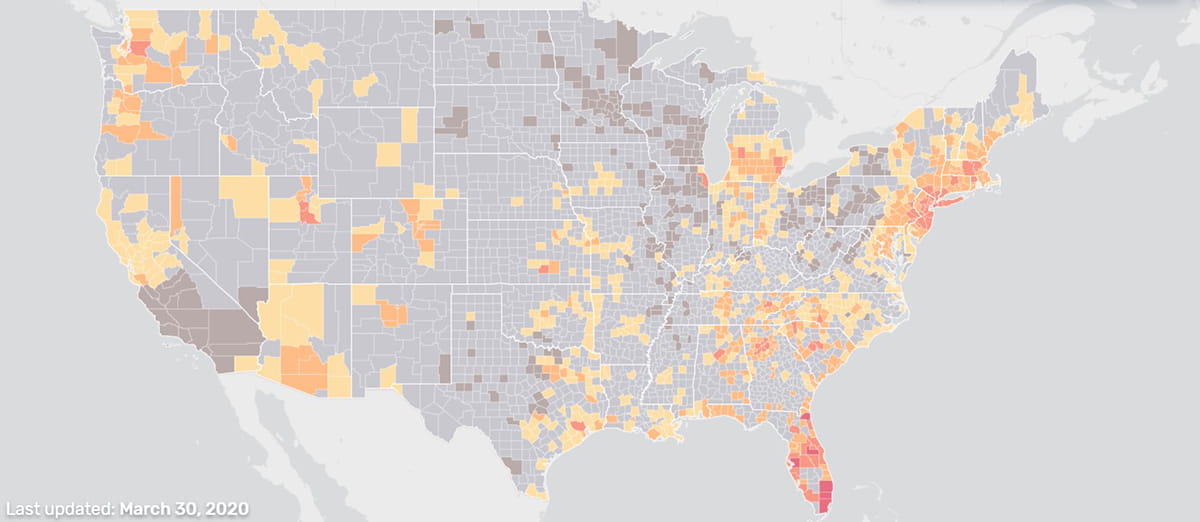Nordic Semiconductor today announces that U.S. connected health specialist, Kinsa Health, is using data from millions of Nordic nRF52810-based Bluetooth smart thermometers in the U.S. to help combat the spread of the Covid-19 virus.
Anonymized data from the Kinsa App has for several years enabled Kinsa Health to produce a temperature heat map of the U.S. (that Kinsa calls its
US Health Weather Map) that could be used to identify potential Covid-19 hotspots much more quickly and help government agencies and healthcare organization in their on-going battle against the virus.
“A high fever is considered one of the key symptoms of Covid-19 so being able to track this health data is an extremely powerful way to quickly identify any new outbreaks,” says Kinsa Health CTO and VP of Engineering, David Gal. “If testing and containment resources can then be focused on these areas the spread of the virus could be significantly slowed down and lives saved.”

Screenshot: Kinsa, US Health Weather Map
Kinsa currently offers two smart thermometers: the low cost Kinsa QuickCare oral thermometer that can provide a temperature reading in around eight seconds; and the Kinsa Smart Ear aural thermometer that can supply a temperature reading in as little as one second. Both connect via Bluetooth to the Kinsa App that can not only keep a log of readings but also provide users with a range of benefits including guidance on when to seek further medical advice, provide medication reminders, and even deliver animations to keep children distracted for long enough that an accurate reading of their temperature can be taken.
“Our users use our thermometers in tandem with an app, which serves as a ‘nurse in the pocket’ providing real-time guidance on how severe their illness is and what to do next,” summarizes Gal. “On the back end we anonymize and aggregate temperature and symptom inputs to realize an illness signal, which tells us what percentage of a population is ill in any given U.S. geography be that county, state, or HHS region. Additionally, using machine learning and AI, we forecast these illness signals. We use these signals and forecasts to help predict and curb the spread of disease outbreaks.”
Gal adds that because all Kinsa’s smart medical devices are battery-powered (a CR2032 coin cell in the QuickCare and a pair of AAAs in the Smart Ear) it required an ultra low-power Bluetooth Low Energy solution, but one that also had enough on-board processing power and memory to essentially run the entire smart medical application from a single chip.
“We selected Nordic for many reasons,” says Gal. “Nordic’s documentation is the best in the Bluetooth market bar none, which is vitally important for any medical device manufacturer. Also all excellent are their reference designs, datasheets, sample code, and SDKs. And Nordic’s legendary technical support is simply incredible. Nordic helped us with everything from tuning antennas to customization of firmware to passing Bluetooth SIG qualification testing. Every Kinsa product has gone to market on time and that is due in no small part to the fact that Nordic Semiconductor was behind us. We couldn’t have done it without them.”
The Nordic Semiconductor nRF52810 SoC, based on Nordic’s proven nRF52 Series architecture, has the lowest power consumption in the nRF52 Series and brings the 2Mbps higher throughput, improved coexistence, and increased broadcast capacity with advertising extensions benefits of Bluetooth 5 to the most cost-sensitive, high-volume applications. The nRF52810 SoC retains the 64MHz, 32-bit ARM® Cortex® M4 MCU of other nRF52 Series SoCs maintaining the performance demanded when employing functionality such as Bluetooth LE secure connections and 2Mbps data processing. In addition, the nRF52810 SoC’s Flash-based software architecture brings over-the-air (OTA) application upgrades to products previously excluded by cost constraints.
Kinsa is a public health startup that since 2012 has focused on tracking and curbing the spread of infectious diseases including influenza-like illness. This is done via the use of affordable yet accurate, high quality smart medical devices such as thermometers. In the U.S. over 9 in 10 of the smart thermometers sold in the last 12 months were made by Kinsa Health.

